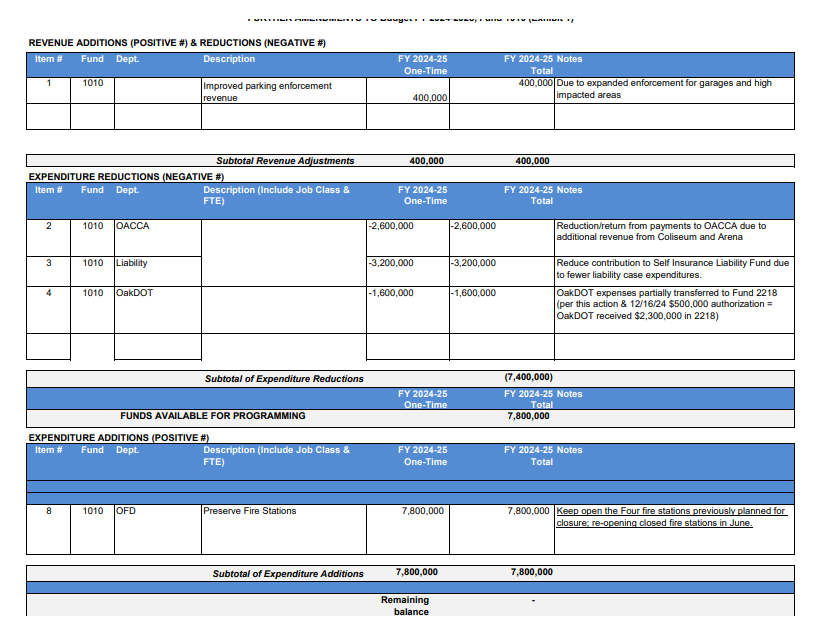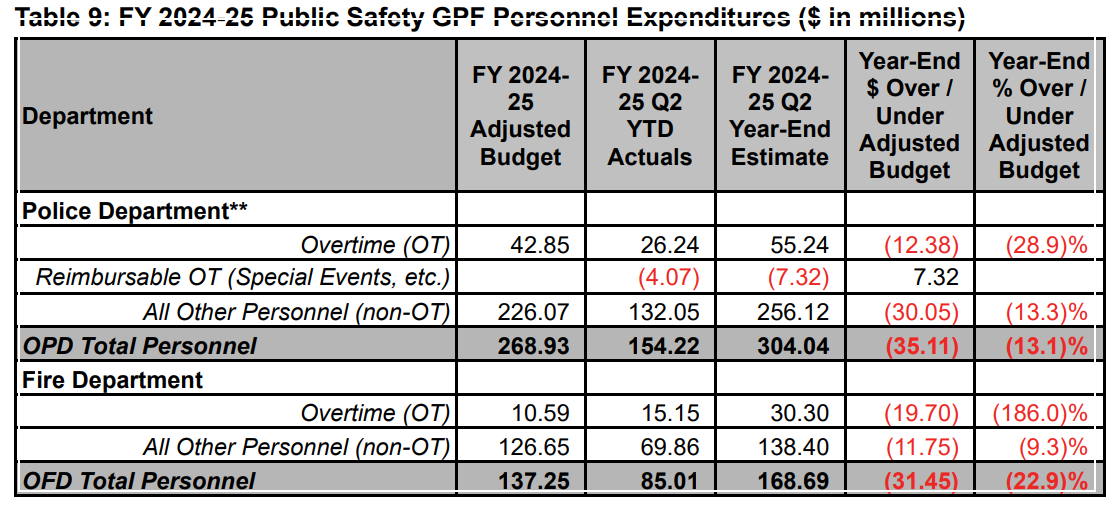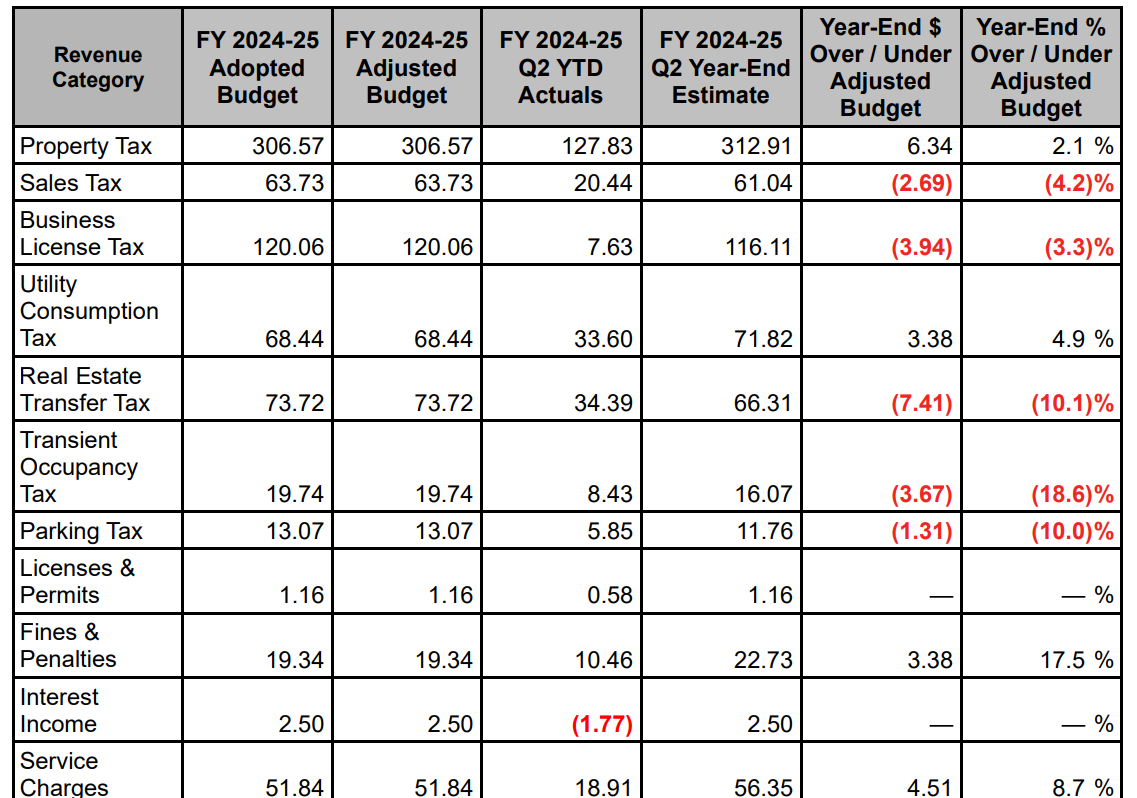At a March 4 Council meeting, CMs Janani Ramachandran, Rebecca Kaplan and Zac Unger are scheduled to introduce revenue-allocating legislation that would keep open four Oakland firehouses slated for closure in December’s spending cut plan. The proposed OFD re-funding plan—which the City Administrator’s Office [CAO] supports and has already incorporated into the City's spending plan—will be juxtaposed alongside a Q2 revenue and expenditure report from the Finance Department that shows an improved, but still dire, projected General Purpose Fund [GPF] budget deficit.
The Q2 report will be discussed at a special Finance Committee meeting this Thursday. The report projects an $89 MM deficit in the GPF by fiscal year's end based on spending and revenue patterns and assumptions from July to December 2024. In the report, however, the Finance Department expresses confidence budget balancing measures commenced in late December and January and new changes in the City's economic prospectus will bring a positive GPF fund balance by year’s end.
4 Fire Stations Slated for Closure Will be Kept Open with Incoming Revenue and Cost-Rebalancing
Funding to forego the “brownout” closures announced in December, would come from an expected $2.6 MM rebate of Coliseum JPA fees; GPF money saved by transferring qualifying OakDOT expenses to the Measure BB Transportation Tax fund; and $3.2 MM of an expected reduced self-insurance liability expense. The full amount available to keep the stations open is given as $7.8 MM in an accompanying spreadsheet—about $300K short of the original amount claimed in a press conference and Rules Committee statements previously. A line in the accompanying spreadsheet says funds to reopen the currently closed stations—25 and 28, in the hills areas of D4 and D6—would be found by June, but they'll remain closed for the time being. An earlier version of the refunding rubric counted on some level of Affordable Housing Trust Fund [AHTF] monies, but that's been removed. The AHTF fund balance will likely end at a negative amount if the 5 MM borrowed by the GPF is not returned, however, according to the report. A $1 MM eviction defense grant [Oakland Housing Secure] based on the fund was finally scheduled to the March 4 council meeting from rules last Thursday.

The CAO apparently supports deleting the fire station closures and has incorporated the funding allocation into the second quarter revenue and expenditure report, noting the “[closure] measure has been removed from the current plan due to operational and public safety considerations.”
As of December, the end of the 2024-25 fiscal year second quarter, the City is still projected to come in at $89 MM* over budget, according to the report—with the important caveat that many of the CAO’s cost-reductions began as the second quarter was ending and afterward. In the report, the Finance Department says that the balancing actions are expected to right the budget by year’s end with a minor surplus.
Expenditure Overages Driven by High Spending in Public Safety, Led by OPD
Almost all of the expenditure side of the budget imbalance is driven by OPD and OFD. Despite attempts to reign in the spending, the City’s two largest GPF expenditures continue to be over-budget—even in the City’s reduced “contingency” budget and in December’s budget balancing reductions. OFD is also over budget by around $30 MM. OFD usually is able to drive down overtime expenditure with vacancy savings at year’s end, which the report notes is the traditional outcome—that will likely be bolstered the ongoing two-station closure. Some other departments are also overspending slightly, including the City Administrator’s office, but most are under-spending due to vacancies.
OPD’s Robust Spending Shrugs Off Cost-Cutting
The Q2's banner headline is that OPD will overspend its total contingency/December cuts budget by $38 MM by fiscal year’s end, most of that driven by overspending on overtime. That’s actually about $14 MM over its original Coliseum-reliant budget from July.

But between the lines, the report tells an astonishing tale of runaway police overtime spending. As part of December’s cuts, the CAO moved to reduce OPD’s total fiscal year overtime budget by about 50%. At that time, that was around $20 MM—which would reduce the contingency-budgeted overtime allocation from $42.8 MM to $22.8 MM. But by then, halfway through the fiscal year, it turned out that OPD had already spent $27 MM in overtime, making that limit functionally meaningless.
In December, according to the report, the City Administrator then tried to "align monthly overtime expenditures with the budget expectations" by reducing overtime expenses by 20%. The report deems the more modest cut a success—but obviously of the pyrrhic kind, because it will still lead to a large over-expenditure. According to the report OPD is projected to spend $55 MM in overtime based on the first half-FY spending pattern—over $30 MM higher than December’s ostensibly reduced overtime budget and $13 MM higher than even the original July overtime budget**. It's unclear in the report whether the OPD is expected to achieve a higher level of savings going forward that will significantly reduce that projected overage. The updated spreadsheet for OPD shows that an expected $25 MM reduction in overtime [and special unit spending] has become $1.45 MM.


Revenues Continue Underperforming
The City’s revenues are actually marginally lower than the first quarter prediction, about $2 MM lower. Despite this, some revenue streams such as property tax and Fines/Penalties [mostly from expected increased parking enforcement revenue] performing better than predicted. Others have performed worse than predicted, like Real Estate Transfer Tax, Sales Tax, Business License Tax and Transient Occupancy [Hotel] Tax.

Reductions in Layoffs Difficult to Gauge in Report
The Q2 report says that its initial workforce assessment was faulty–and that certain proposed layoffs aren’t necessary now as balancing measures have been implemented. The report opaquely notes the fact that an internal CAO memo appears to have rescinded some layoffs as reported here last week: “the City has been able to preserve more jobs than initially anticipated.”
The full scope of the layoffs is still difficult to gauge in the report, as they are expressed as monetary line items and not disaggregated by job title, but almost all line items with a position elimination in the spreadsheet show reduced or deleted values in the update. Nevertheless, informed sources have told OO that layoff notices for Extended Limited Duration Employee positions were received by workers after the rescinding memo went out.
City Administrator Expresses Confidence Budget Will Balance by FY’s End
Despite the current projection, the report, which is limited to data from the first half of the fiscal year, expresses confidence that cost-cutting measures undertaken in late December and January will balance the budget—even when allowing for the fire stations remaining open, high police spending, and reduced layoffs. But the City Administrator appears to also be suggesting another round of contract cost-cutting for about $2.5 MM with a “placeholder” amount.
*the report says that this is a decrease from $129 MM overage, but its not clear where this number is derived. The Q1 report noted a $114 MM projected gap. Much of the difference between the $114 MM imbalance in the Q1 projection and the $89 MM imbalance in Q2, seems to be in the reduction of expected legal settlement payouts and absence of mandatory carryforwards.
**The report claims that OPD has reduced its over all expenditure by $13 MM since the Q1 report—but it's clear that the reduction in real terms is only $9 MM, and only appears to be $13 MM because the OPD’s baseline budget was increased by $4 MM after the Q1 report. The overtime amount could be reduced if reimbursable overtime of about $7 MM is included in the calculation, according to the report.

Comments ()